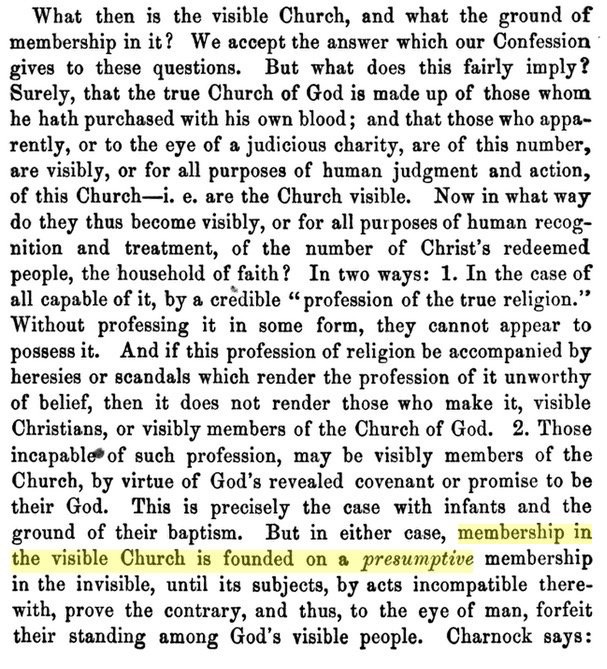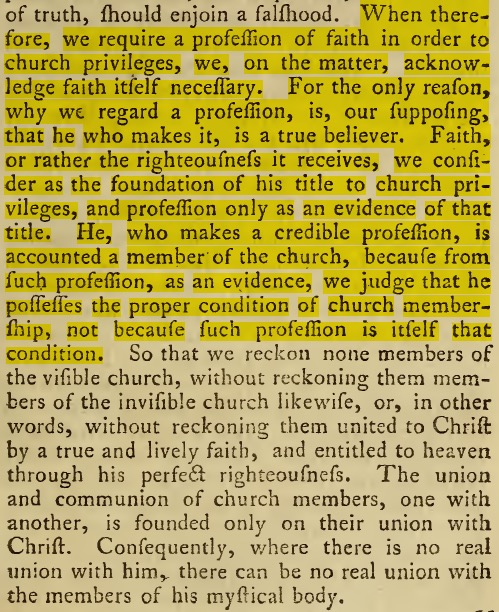11
May
2016
In
By Brandon Adams
When Did the Church Begin?
On 11, May 2016 | In | By Brandon Adams
The church began in Genesis 3:15 and the church began at Pentecost.
How can both be true? Because of the visible/invisible church distinction as it relates to the promised/established New Covenant.
Old Testament saints were saved in the same way that we are today: through saving faith produced by the regenerating power of the indwelling Holy Spirit (2LBC 8.6, 8.8, 10.1, 11.6). They were united to Christ and were therefore part of his mystical body, the church (2LBC 26.1).
But it does not therefore follow that Israel was the church (“assembly”) of Christ. Israel was an assembly, but not the assembly of Christ (Heb. 12:23). Though regenerate Old Testament saints were part of the body of Christ, they were a remnant within the broader body of the assembly of Israel (which was governed by the Old Covenant). Likewise, believers outside of Israel were not under the Old Covenant (for example, Lot & Melchizedek were not circumcised – see Coxe p. 117-118).
It was not until Pentecost that the invisible church gathered (“assembled”) together as the assembly of Christ (the church) (2LBC 26.2, 26.5-7). The visible church was instituted at Pentecost and given ordinances of worship and its own government. John Owen explains how this relates to the New Covenant as promised & established.
This is the meaning of the word nenomoqe>thtai: “established,” say we; but it is, “reduced into a fixed state of a law or ordinance.” All the obedience required in it, all the worship appointed by it, all the privileges exhibited in it, and the grace administered with them, are all given for a statute, law, and ordinance unto the church. That which before lay hid in promises, in many things obscure, the principal mysteries of it being a secret hid in God himself, was now brought to light; and that covenant which had invisibly, in the way of a promise, put forth its efficacy under types and shadows, was now solemnly sealed, ratified, and confirmed, in the death and resurrection of Christ. It had before the confirmation of a promise, which is an oath; it had now the confirmation of a covenant, which is blood. That which before had no visible, outward worship, proper and peculiar unto it, is now made the only rule and instrument of worship unto the whole church, nothing being to be admitted therein but what belongs unto it, and is appointed by it. This the apostle intends by nenomoqe>thtai, the “legal establishment” of the new covenant, with all the ordinances of its worship. Hereon the other covenant was disannulled and removed; and not only the covenant itself, but all that system of sacred worship whereby it was administered. This was not done by the making of the covenant at first; yea, all this was superinduced into the covenant as given out in a promise, and was consistent therewith. When the new covenant was given out only in the way of a promise, it did not introduce a worship and privileges expressive of it. Wherefore it was consistent with a form of worship, rites and ceremonies, and those composed into a yoke of bondage which belonged not unto it. And as these, being added after its giving, did not overthrow its nature as a promise, so they were inconsistent with it when it was completed as a covenant; for then all the worship of the church was to proceed from it, and to be conformed unto it. Then it was established. Hence it follows, in answer unto the second difficulty, that as a promise, it was opposed unto the covenant of works; as a covenant, it was opposed unto that of Sinai. This legalizing or authoritative establishment of the new covenant, and the worship thereunto belonging, did effect this alteration. (Exposition of Hebrews 8:6)
The first solemn promulgation of this new covenant, so made, ratified, and established, was on the day of Pentecost, seven weeks after the resurrection of Christ. And it answered the promulgation of the law on mount Sinai, the same space of time after the delivery of the people out of Egypt. From this day forward the ordinances of worship, and all the institutions of the new covenant, became obligatory unto all believers. Then was the whole church absolved from any duty with respect unto the old covenant, and the worship of it, though it was not manifest as yet in their consciences. (Exposition Hebrews 8:10)
Thus the church began as soon as God began to redeem lost sinners through the promise of the New Covenant (Gen. 3:15), which was efficacious to save, bringing an individual into the invisible church. But it was not until the New Covenant was formally established that the visible church was instituted with its own worship and governance. Consider Samuel Waldron’s Exposition of the 1689 Confession on this point:
Does the Bible teach that this universal church consists of all the elect? Here a distinction is crucial. The church is the final, organized, earthly expression of the people of God. We must distinguish between the church as an institution and the church as the people of God. Such a distinction enables us to do justice to portions of the New Testament which are frequently misinterpreted. There was a very important sense in which the church began as an institution and organism in the complex of events surrounding Christ’s first advent. There was a sense in which historically the church began in the vents of Christ’s earthly ministry, death, resurrection and pouring out of the Spirit. The apostles of Christ are the historical foundation upon which Christ is now building his church (Matt. 16:18; Eph. 2:20; Heb. 12:18-24). The future tense in the statement of Christ, ‘I will build my church’, may, therefore, be given its natural force. Though Israel was a type of the church (Rom. 2:28-29; 1 Cor. 10:18; Gal. 6:16; Phil. 3:3) and though the church is the new Israel of God and the fulfillment of prophecy (Acts 2:16; 15:14-18; 1 Cor. 10:11; Gal. 6:16; Eph 2:12-19; Heb. 8:7-13), it is true that the church as an institution and organism did not exist in the Old Testament. These truths contradict the tendency of some strains of covenant theology to flatten the difference between the church and Israel in the interests of paedo-baptism.
On the other hand, the church is the climactic earthly expression of the people of God. Thus language is frequently used which equates the church with all those in union with Christ. The church is the body and bride of Christ (Eph. 1:22; 4:11-116; 5:23-27, 29, 32; Col. 1:18; 2:4). Furthermore, the bride of Christ is composed in the last day of the saved from every age (Eph. 5:27; Rev. 21:9-14; note also Matt. 8:11-12; John 10:14-17; Heb. 11:39-40). Thus the church will one day be composed of all the redeemed. As the people of God, the church does consist ‘of the whole number of the elect’. These considerations refute Dispensationalism with its church/Israel distinction and its denial that the Old Testament saints are part of the church.
For more, see Tom Ascol’s Toward a Confessional Doctrine of the Church (3-Part Video).
[Link to this question]



